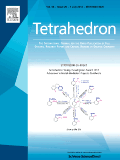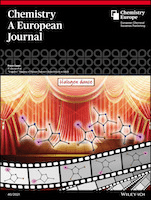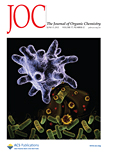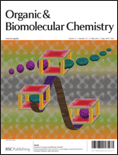
TETRAHEDRON
Scope & Guideline
Elevating scientific dialogue with rigorous peer-reviewed research.
Introduction
Aims and Scopes
- Organic Synthesis:
The core focus of Tetrahedron is on organic synthesis methodologies, including the development of new synthetic routes, reactions, and strategies that enhance the efficiency and selectivity of chemical transformations. - Catalysis:
The journal showcases advancements in catalytic processes, including homogeneous and heterogeneous catalysis, with a particular emphasis on environmentally friendly and sustainable methods. - Medicinal Chemistry:
Research articles often explore the synthesis and biological evaluation of new pharmacological agents, highlighting the connection between synthetic chemistry and drug development. - Materials Science:
Tetrahedron publishes studies on the synthesis and characterization of novel materials, including polymers and nanomaterials, focusing on their applications in various fields such as electronics and biomedicine. - Theoretical and Computational Chemistry:
The journal includes computational studies that assist in understanding reaction mechanisms, predicting outcomes, and providing insights into the structure-activity relationships of synthesized compounds.
Trending and Emerging
- Sustainable Chemistry:
There is an increasing number of articles dedicated to green synthesis methods, emphasizing the development of processes that minimize environmental impact and utilize renewable resources. - Photoredox Catalysis:
The use of visible-light-mediated synthetic methodologies is gaining traction, with numerous papers exploring photoredox catalysis as a versatile tool for generating complex organic molecules. - Bioconjugation and Chemical Biology:
Research focusing on bioconjugation strategies and the synthesis of compounds with biological relevance is on the rise, reflecting a trend towards integrating organic synthesis with biological applications. - Nanomaterials and Nanocatalysis:
There is a noticeable increase in studies exploring the synthesis and application of nanomaterials in catalysis and drug delivery, highlighting their potential in addressing contemporary challenges in chemistry and medicine. - Multicomponent Reactions:
The trend towards multicomponent reactions is evident, with research highlighting their efficiency in synthesizing complex molecules in a single step, thus streamlining synthetic processes.
Declining or Waning
- Traditional Organic Reactions:
There has been a noticeable decline in the number of publications focused on classical organic reactions that do not incorporate modern advancements or applications, such as traditional nucleophilic substitutions or electrophilic additions. - Synthetic Methodologies with Limited Novelty:
Research that presents incremental advancements in well-established synthetic methodologies without significant innovation or new applications appears to be less frequent, suggesting a shift towards more novel and impactful contributions. - Isolated Natural Product Synthesis:
The synthesis of isolated natural products without a clear application or relevance to broader synthetic challenges is becoming less common, as the focus shifts towards compounds with therapeutic potential or broader implications.
Similar Journals

Heterocyclic Letters
Pioneering Discoveries in Medicinal and Agricultural ChemistryHeterocyclic Letters is an esteemed journal in the field of synthetic organic chemistry, published by RAMAN PUBL. With ISSN 2231-3087 and E-ISSN 2230-9632, this journal aims to disseminate original research and innovative findings related to heterocyclic compounds, which play a crucial role in medicinal chemistry, material science, and agricultural chemistry. Heterocyclic Letters provides a platform for researchers, professionals, and students to share their insights and advancements, thus fostering academic collaboration and knowledge transfer. The journal is dedicated to maintaining high-quality standards in research publication, making it an essential resource for anyone focused on the latest developments in heterocyclic chemistry. Although it does not currently offer Open Access options, the journal’s rigorous peer-review process ensures that only the most credible and impactful studies are published, contributing significantly to the advancement of the field.

RUSSIAN JOURNAL OF GENERAL CHEMISTRY
Unveiling Breakthroughs in Chemical ScienceThe Russian Journal of General Chemistry is a prominent scholarly publication dedicated to advancing the field of general chemistry. Published by MAIK NAUKA/INTERPERIODICA/SPRINGER, this journal contributes significantly to the global chemistry landscape, offering a platform for researchers and professionals to share their latest findings and methodologies. With an ISSN of 1070-3632 and an E-ISSN of 1608-3350, it has established itself as a resource for high-quality research articles since its inception in 1996. Though currently indexed in the Q4 category for chemistry (miscellaneous) and ranking #299 out of 408 in general chemistry according to Scopus, the journal remains an important venue for academic contributions that bridge gaps in traditional chemical disciplines. Desiring to cater to a diverse range of interests within chemistry, the journal actively encourages submissions that reflect significant scientific achievements, innovations, and collaborative studies. Although the journal does not currently offer open access, its role in disseminating crucial chemical research cannot be overstated. Researchers and students alike will find valuable insights and rigorous scientific discourse in its pages.

CHEMISTRY-A EUROPEAN JOURNAL
Advancing the Frontiers of Chemical ResearchCHEMISTRY-A EUROPEAN JOURNAL is a premier academic journal published by WILEY-V C H VERLAG GMBH, specializing in the diverse fields of chemistry and catalysis, with a distinguished focus on organic chemistry. Since its inception in 1995, the journal has established itself as an authoritative resource for researchers and professionals, currently classified in Q1 in Chemistry (miscellaneous) and Organic Chemistry, reflecting its high-quality contributions to the scientific community. With an impressive impact factor and robust Scopus rankings—#33 in Organic Chemistry and #26 in Catalysis—this journal serves as a vital platform for disseminating innovative research findings and critical advancements in chemical sciences. Although not an open-access journal, it provides valuable access options for institutions, ensuring wide reach and engagement within the scientific community. As it converges into 2024, CHEMISTRY-A EUROPEAN JOURNAL remains a key resource for anyone dedicated to advancing the frontiers of chemistry research.

JOURNAL OF ORGANIC CHEMISTRY
Fostering Excellence in Organic Chemistry ResearchJournal of Organic Chemistry, published by the American Chemical Society, is a prestigious peer-reviewed journal dedicated to advancing the field of organic chemistry. With an ISSN of 0022-3263 and an E-ISSN of 1520-6904, this journal has established itself as a key platform for disseminating high-quality research since its inception in 1936. Residing in the Q2 category for Organic Chemistry as of 2023, it ranks #64 out of 211 in Scopus, positioning itself within the top 69th percentile of its field. Researchers and professionals can access vital findings and innovative methodologies that drive the understanding and application of organic chemical principles. Although the journal is not open access, it remains a crucial resource in academia and industry, contributing significantly to the scientific community's knowledge base. For detailed insights and cutting-edge research, the journal continues to be an essential read for those engaged in the dynamic and evolving landscape of organic chemistry.

HELVETICA CHIMICA ACTA
Exploring the Depths of Chemical ScienceHELVETICA CHIMICA ACTA, published by WILEY-V C H VERLAG GMBH, stands as a pivotal journal in the fields of chemistry and chemical research. Established in 1918, this esteemed journal spans a diverse array of topics, including biochemistry, catalysis, drug discovery, inorganic and organic chemistry, as well as physical and theoretical chemistry. With influence reflected in its noteworthy Q2 and Q3 quartile rankings across these categories as of 2023, HELVETICA CHIMICA ACTA continues to capture the interest of the global scientific community. Although not an open-access journal, it remains accessible through various academic institutions, ensuring broad reach and collaboration opportunities. Researchers, professionals, and students alike will find its meticulously peer-reviewed articles critical for advancing knowledge and fostering innovation within the chemical sciences. As the journal converges toward 2024, it remains committed to publishing high-quality, impactful research that supports the evolution of chemistry across its multifaceted disciplines.

ORGANIC & BIOMOLECULAR CHEMISTRY
Connecting researchers through high-quality, open-access studies.ORGANIC & BIOMOLECULAR CHEMISTRY is a prestigious academic journal published by the Royal Society of Chemistry, dedicated to advancing the fields of organic and biomolecular chemistry. With its ISSN of 1477-0520 and E-ISSN of 1477-0539, this journal plays a pivotal role in disseminating high-quality research and contributing to the scientific community, particularly in biochemistry, organic chemistry, and physical and theoretical chemistry. Currently ranked in the third quartile for Biochemistry and the second quartile for Organic Chemistry and Physical and Theoretical Chemistry, it caters to a diverse audience of researchers, professionals, and students who seek insightful studies and reviews. With a publication history spanning since 2003 and ongoing till 2024, the journal fosters open access to its articles, encouraging the free exchange of knowledge. Situated in the vibrant academic environment of Cambridge, UK, ORGANIC & BIOMOLECULAR CHEMISTRY serves as a vital resource for innovative research at the intersection of chemical sciences.

ACS Organic & Inorganic Au
Elevating Research Standards in Chemical InnovationACS Organic & Inorganic Au, published by the American Chemical Society, stands as a premier open-access journal dedicated to advancing the fields of organic and inorganic chemistry. Since its inception in 2021, this journal has swiftly risen to prominence, achieving a commendable Q1 classification in Inorganic Chemistry, Organic Chemistry, and Physical and Theoretical Chemistry as of 2023. With an ISSN of 2694-247X, it provides a vital platform for researchers, professionals, and students to disseminate their findings and engage with cutting-edge work across converged disciplines. Operating from its headquarters in Washington, DC, ACS Organic & Inorganic Au is committed to fostering a collaborative research environment, encouraging rigorous peer review, and ensuring the wide accessibility of high-quality scholarly articles. With its open-access model, readers worldwide can freely access and utilize research findings, promoting a global exchange of knowledge crucial for driving innovation in chemistry.

INDIAN JOURNAL OF HETEROCYCLIC CHEMISTRY
Fostering Collaboration in Heterocyclic ResearchINDIAN JOURNAL OF HETEROCYCLIC CHEMISTRY, published by CONNECT JOURNALS, is a vital resource in the fields of organic chemistry and biochemistry, aiming to advance research and promote innovation within the realm of heterocyclic compounds. Established in 1996, this journal has successfully converged into an influential publication with a commitment to disseminating high-quality, peer-reviewed research articles that enhance the understanding of heterocyclic chemistry applications. Although it currently holds a Q4 quartile ranking in both biochemistry and organic chemistry according to the 2023 categorizations, its broader contributions to the scientific community should not be underestimated, as it seeks to support the ongoing dialogue among researchers, professionals, and students. The journal operates from Ghaziabad, India, providing open access to its publications, thereby fostering a collaborative and informative environment for its international readership. With an ISSN of 0971-1627 and a special focus on contemporary challenges and developments in the field, the INDIAN JOURNAL OF HETEROCYCLIC CHEMISTRY is poised to make a significant impact as it continues to evolve through 2024 and beyond.

MENDELEEV COMMUNICATIONS
Connecting Chemists to Propel Scientific Discovery.Mendeleev Communications, published by Elsevier, is a prominent journal within the field of chemistry that has been providing a platform for innovative research since its inception in 1991. Based in the Netherlands, this journal serves as a vital resource for researchers, professionals, and students looking to advance their understanding of miscellaneous chemistry topics. With a current Q3 ranking in the broad category of Chemistry (miscellaneous) and positioning within the 46th percentile of its field according to Scopus rankings, Mendeleev Communications is committed to disseminating high-quality, original contributions to the scientific community. While the journal is not currently an open-access platform, it ensures rigorous peer-review and editorial standards that contribute to its academic reputation. As it moves toward 2024, Mendeleev Communications continues to play a crucial role in fostering communication among chemists and promoting cutting-edge research that drives the discipline forward.

ChemistrySelect
Unveiling the Future of Chemical DiscoveriesWelcome to ChemistrySelect, a pivotal journal in the field of chemistry published by WILEY-V C H VERLAG GMBH. With its ISSN 2365-6549, this journal aims to provide a comprehensive platform for researchers and practitioners to share significant advancements in various areas of chemistry, contributing to the ongoing dialogue and development within the scientific community. Since its inception in 2016, ChemistrySelect has focused on publishing high-quality research that spans multiple facets of the discipline, earning its place in the Q3 category for Chemistry (miscellaneous) as of 2023. While operating under a subscription model, the journal remains committed to broadening accessibility and engaging a wide audience of researchers, professionals, and students. The journal's objective is to facilitate the dissemination of groundbreaking findings through rigorous peer review, ensuring that the latest studies reflect the evolving nature of chemistry research. As we approach 2024, ChemistrySelect continues to be an invaluable resource for the academic community, positioning itself as a trusted voice in the world of chemical research.